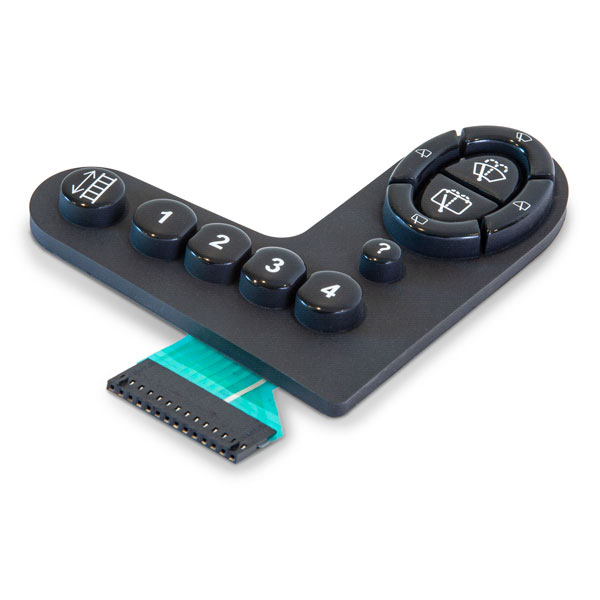Choosing the Right Membrane Switch for Your Business Needs
Choosing the Right Membrane Switch for Your Business Needs
Blog Article
Understanding Membrane Layer Switches: The Trick to Long Lasting and Trustworthy Controls

What Are Membrane Layer Switches?
Membrane switches are an advanced service in the realm of customer interface modern technology, integrating functionality and layout flawlessly. These devices act as a user interface between customers and electronic systems, integrating a number of elements right into a compact style. Normally created from versatile, thin layers of materials, membrane layer buttons are designed to reply to touch, making it possible for users to communicate with machinery and electronic gadgets properly.
The main components of a membrane layer button consist of a published circuit layer, graphic overlay, and a spacer layer that avoids unintended activation. The graphic overlay can be customized to mirror brand identity or individual choices, boosting appearances while ensuring functionality. Membrane layer switches are commonly used in numerous applications, consisting of clinical gadgets, customer electronics, and industrial tools, owing to their resilience and resistance to ecological aspects such as wetness and dust.
Among the vital advantages of membrane layer switches is their ability to hold up against deterioration, making them excellent for high-traffic atmospheres. In addition, they are light-weight and call for minimal area, permitting for innovative styles in product advancement. Generally, membrane layer changes stand for a reliable and useful selection for modern digital user interfaces, marrying modern technology with user-centric style principles.
Just How Membrane Switches Over Work
The operation of membrane layer switches depend upon an easy yet effective device that equates user input into electronic signals. These buttons are composed of several layers, commonly including a visuals overlay, a spacer layer, and a circuit layer. When a customer presses the switch, the leading layer flaws, permitting a conductive element in the circuit layer to make contact with an equivalent conductive pad on the bottom of the graphic overlay. This get in touch with shuts the circuit and sends out an electronic signal to the gadget, showing that the switch has been turned on.
The design of membrane buttons can vary, however they often integrate domes or tactile aspects to offer feedback to the customer, enhancing the total experience - membrane switch. The materials used in membrane layer switches, such as polyester or polycarbonate, add to their toughness and resistance to environmental factors, consisting of moisture and dirt. Moreover, the printed circuits are usually enveloped, which shields them from damage with time.
Advantages of Membrane Switches

Furthermore, membrane buttons are known for their toughness. Created from robust materials, they are immune to dust, wetness, and physical wear, which dramatically extends their life-span compared to standard mechanical switches. This resilience makes them specifically suitable for high-traffic environments and applications calling for long life.
Another substantial benefit is the ease of cleaning and upkeep. The smooth surface area of membrane layer view website changes lessens dirt accumulation and is usually unsusceptible spills, making them perfect for setups that call for frequent sanitization.
Additionally, membrane switches supply a streamlined profile, resulting in a thinner style that can be incorporated right into numerous gadgets without adding bulk. This attribute not just improves the visual charm however also contributes to a more ergonomic product style.
Applications of Membrane Switches
Functional and easy to use, membrane layer buttons find applications throughout a wide variety of sectors, including clinical tools, customer electronic devices, and commercial tools. In the medical area, these switches are integral to devices such as analysis devices, client monitoring systems, and infusion pumps, where reliability and convenience of cleaning are important. Their capacity to endure extreme atmospheres and preserve functionality makes them ideal for such applications.

In customer electronic devices, membrane layer buttons are used in items like microwaves, cleaning machines, and remotes - membrane switch. Their sleek style permits for intuitive interface, enhancing the overall user experience while offering resilience and resistance to use and tear
Industrial devices also profits from membrane switches, especially in control panels for machinery and automation systems. These switches provide security versus dust and moisture, ensuring regular efficiency in challenging environments. In addition, their adjustable functions permit suppliers to customize them to certain operational needs, improving efficiency and performance.
Choosing the Right Membrane Switch
When choosing a membrane layer button, it is vital to consider numerous factors that affect performance and viability for particular applications. The key considerations consist of environmental conditions, tactile comments, durability, and design specs.
First, evaluate the operating environment; switches exposed to dampness, chemicals, or extreme temperature levels need particular products to ensure longevity and capability. Next off, review the requirement for tactile feedback. Depending upon individual communication, some applications may benefit from a tactile response to verify activation, while others might choose a non-tactile design for visual reasons.
Resilience is one more vital aspect; membrane switches ought to be made to endure frequent usage, influences, and abrasion. Guarantee the selected switch can withstand the anticipated lifecycle, specifically in high-usage situations.

Final Thought
In verdict, membrane layer switches over offer as important components in the layout of long lasting hop over to here and reliable control systems across different industries. The versatility of membrane layer changes allows browse around this site for customized options that meet details functional requirements, enhancing their importance in modern-day technology.
Membrane layer switches over stand for an essential aspect of modern user interface design, mixing capability with strength in numerous applications.Membrane layer switches are an innovative service in the realm of user interface modern technology, combining functionality and design seamlessly. Usually built from adaptable, slim layers of materials, membrane buttons are made to react to touch, enabling customers to communicate with machinery and digital tools properly.
The style of membrane layer buttons can vary, yet they usually integrate domes or tactile aspects to offer comments to the customer, improving the general experience.In conclusion, membrane layer switches serve as crucial components in the design of reputable and long lasting control systems across different markets.
Report this page